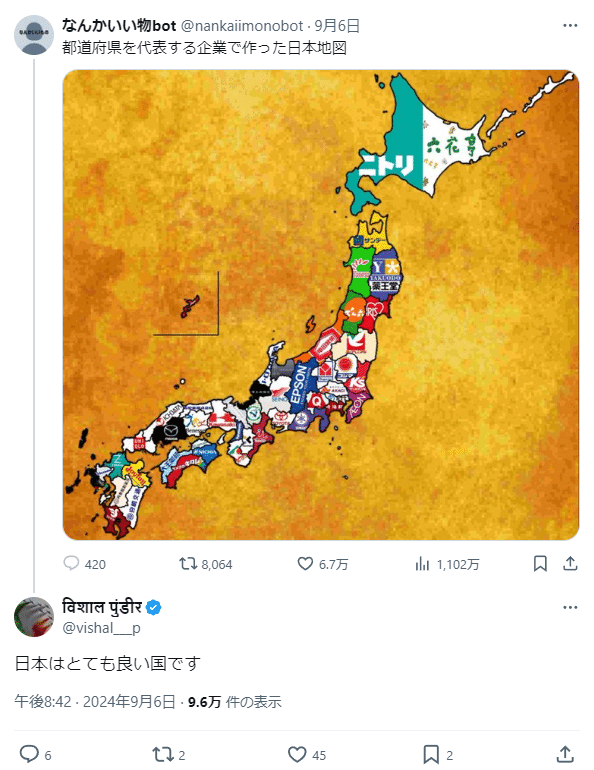The monetization of X, one of Japan’s most-used social networking platforms, has had some unfortunate externalities. One is the uptick in accounts – most from outside of Japan – clogging up replies of popular accounts and posting sensationalistic content with the intent of going viral. Japanese users have dubbed them “impression zombies” (インプレゾンビ, inpure zombi).
At their most harmless, the impression zombies make X harder to navigate. At their worst, however, they can spread dangerous disinformation.
Impression zombies: Trash for cash
The stock-in-trade of impression zombies is twofold. The first is copying popular content from social media and re-posting it as their own – i.e., the traditional content theft that’s rampant on social networks.
The other is posting nonsense replies on threads that have gone viral. These can range from an emoji to nonsense Japanese text like 「ここでは毎日が新しい物語です」(“every day here is a new chapter.”)
Why do they do this? For the money. One 30-something man in Pakistan told NHK News he got hooked on impression zombie work after posting simple one-word replies on news about the Noto Peninsula earthquake and the Haneda Airport plane collision. A simple “Wow” or “Yes” would earn him 10K or more impressions.

A relative pot of gold
An impression refers to how many times a post or comment was seen. Unlike reach, which defines how many people saw a piece of content, impressions count repeated views by the same user. X has made impressions a key metric by showing impression counts on individual posts and setting a minimum impressions threshold for monetization.
Impression zombies are banking on earning enough impressions to qualify for X’s ad revenue-sharing program. That requires not just subscribing to X oneself but earning five million organic impressions on one’s posts over the past three months.
Advertisements
Planning a trip to Japan? Get an authentic, interpreted experience from Unseen Japan Tours and see a side of the country others miss!
“Noah [at Unseen Japan] put together an itinerary that didn’t lock us in and we could travel at our own pace. In Tokyo, he guided us personally on a walking tour. Overall, he made our Japan trip an experience not to forget.” – Kate and Simon S., Australia

Keep all you devices connected in Japan – rent a pocket wifi device! Available for hotel pickup or delivered to your airport. Fast speeds and backed by excellent customer service. (Note: Affiliate link – Unseen Japan earns a commission if you make a purchase.)
How much can an impression zombie make? Probably not much. Creators with followers in the 8,000 to 12,000 range report bringing in between USD $100 to $250 for their first payments.
For someone like the man in Pakistan, however, that would be a windfall. Between awful floods in 2022 and the devastation wrought by the global health crisis, the man says he makes a mere 8,000 yen (USD $56.58) a month. An additional USD $100 would mean he’d be earning 3x his normal take. That’s money, he told NHK, that he could use to help feed and clothe his two kids.
The flooded Tama River that wasn’t

At the most, these junk comments are annoying. However, other posts propagate false information during emergencies that could cause mass panic. They could even end up misdirecting precious resources – which could get people hurt or killed.
NHK cites one post from earlier this year during the Noto Peninsula earthquake. The user claimed to be a Japanese woman whose husband’s foot was stuck in rubble. She claimed he wasn’t breathing and that she couldn’t get a hold of emergency services. The post, however, was pure fiction.
In a more recent example, multiple users claimed that the Tama River, which runs through Tokyo and Kawasaki, was overrun due to torrential rain. It was a believable story. Other users were already posting real reports about the so-called “guerilla downpours” (ゲリラ豪雨; gerira gouu), sudden and unpredictable heavy rainfalls that appear out of nowhere. Videos showed rain pouring into train stations in Minato City and elsewhere.
But the Tama River flooding reports were also a fabrication. Fortunately, no one was hurt as a result of these posts. But they held the power to trigger a mass panic and self-evacuation.
What can be done about impression zombies?
How prevalent are impression zombies? To get a read on this, Tetsuya, a member of the Japanese YouTuber group Tokai On Air with an X following of over 2.5M, ran an experiment. He posted to his X account asking people to hype the tweet but not reply to it.
The result, Tetsuya says, was that “99% or more” of the interactions were from impression zombies. (You can see for yourself in the thread.) Tetsuya says the replies were so furious that “my notifications broke – and are still in crap condition [days later].”
X doesn’t appear to have any strategy to deal with these garbage posts. According to at least two strategy firms, X user counts are dropping – which means the company has negative incentive to crack down on activity.
That means it’s up to consumers and other companies to filter out the noise. For example, LINE Yahoo announced last month that it was implementing anti-impression zombie logic into its Yahoo! Realtime Search. The feature enables users to search and see trending topics on X without logging in. Users have complained that this feature is now useless because impression zombies cause fake information and stolen content to trend in place of real news.
Meanwhile, browser extensions, such as Chrome’s x-zombie-killer, promise to help filter out the noise. A reviewer for Gizmodo JP says the extension, created by freelance developer Kobayashi Yuki, works well enough. However, it only seems to filter out zombies with non-Japanese names. Additionally, it only works in the Chrome browser, which doesn’t help smartphone app users.
Sayonara to X?
For years, X/Twitter has been the third most popular “Social Networking Service” (SNS) in Japan. LINE and YouTube take the first and second spots in this broad category of “social media” apps. X’s popularity has meant the service has an outsized grip on the national conversation. Viral tweets on social topics, such as sexism in the Japanese workplace, frequently make headline news.
However, after Elon Musk’s takeover and the emphasis on subscriptions, many users contemplated a move to other platforms. Some even suggested reviving Mixi, Japan’s old Facebook alternative that is, somehow, still working.
The migration talk picked up again after several waves of account freezes, some of which shut down a few large accounts. However, the lack of a true alternative service of X’s scale and feature set has kept most users from moving.
Alternative services like Threads are picking up steam. Both Threads and Bluesky saw a spike in usage recently after judges in Brazil shut down X there. Courts punished Elon Musk’s service for refusing to appoint a local representative and pay outstanding fines.
However, even Threads – currently the most viable X-killer – has only 30 million users, compared to over 300 million on X. Even close to two years after Musk’s takeover, no service has managed to seize X-like momentum.
It remains to be seen whether users will continue to leak out of X and where they will go. For now, the service remains Japan’s choice for text-based social media. That means, at least for now, impression zombies will remain a fact of life.
Sources
SNSで横行 “インプレゾンビ”の正体は?投稿者に直撃すると… NHK News
「多摩川氾濫」してないのにトレンド入り… 過去画像&インプレゾンビ拡散で東京都副知事「公式サイトから一次情報を」JCast News
インプレゾンビ率は「体感99%以上」 東海オンエアてつやの「実験結果」に反響「バイオハザードご苦労様でした」J-Cast News
LINEヤフー、「Yahoo!リアルタイム検索」におけるインプレゾンビ対策を強化へ. CNet Japan
Xのインプレゾンビを消すChrome拡張を使ってみた. Gizmodo JP
X’s Creator Monetization Standards. X
Ads Revenue Sharing. X
X Creator Pay: Is X’s Ad Revenue Pay Worth it for Content Creators? Hubspot
With Musk’s X banned in Brazil, its users carve out new digital homes. Associated Press
Fewer people are using Elon Musk’s X as the platform struggles to attract and keep users, according to analysts. NBC News








